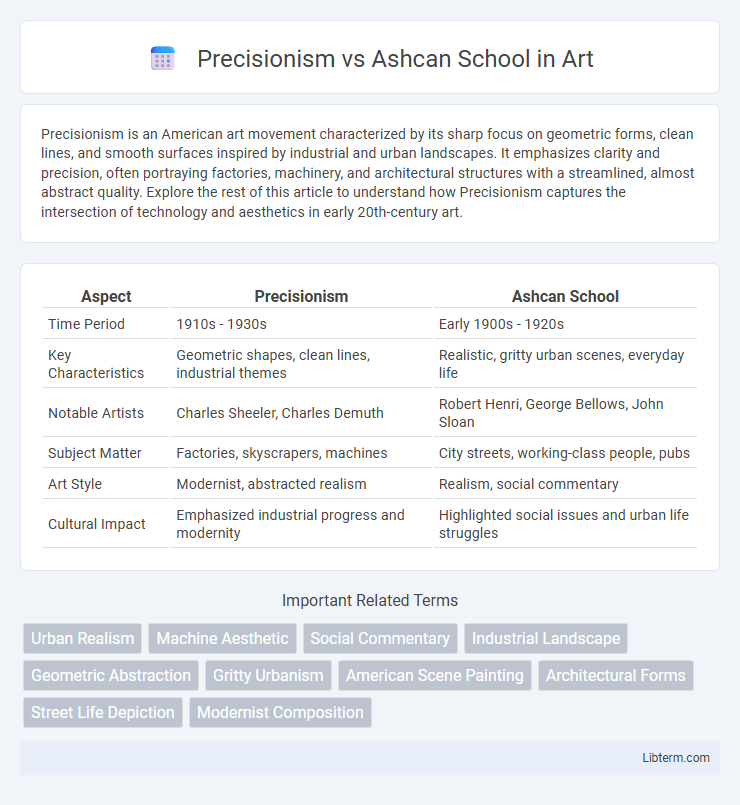Precisionism is an American art movement characterized by its sharp focus on geometric forms, clean lines, and smooth surfaces inspired by industrial and urban landscapes. It emphasizes clarity and precision, often portraying factories, machinery, and architectural structures with a streamlined, almost abstract quality. Explore the rest of this article to understand how Precisionism captures the intersection of technology and aesthetics in early 20th-century art.
Table of Comparison
| Aspect | Precisionism | Ashcan School |
|---|---|---|
| Time Period | 1910s - 1930s | Early 1900s - 1920s |
| Key Characteristics | Geometric shapes, clean lines, industrial themes | Realistic, gritty urban scenes, everyday life |
| Notable Artists | Charles Sheeler, Charles Demuth | Robert Henri, George Bellows, John Sloan |
| Subject Matter | Factories, skyscrapers, machines | City streets, working-class people, pubs |
| Art Style | Modernist, abstracted realism | Realism, social commentary |
| Cultural Impact | Emphasized industrial progress and modernity | Highlighted social issues and urban life struggles |
Introduction to Precisionism and the Ashcan School
Precisionism, emerging in the early 20th century, emphasized clean lines, geometric forms, and the depiction of industrial America, reflecting modernization and technological progress. The Ashcan School, active predominantly in the early 1900s, focused on realistic and gritty portrayals of urban life, capturing everyday scenes and working-class struggles in New York City. Both movements diverged in style and subject matter, with Precisionism celebrating industrial precision while the Ashcan School highlighted raw, unidealized human experiences.
Historical Context and Origins
Precisionism emerged in the 1910s and 1920s amid rapid industrialization and urban growth in the United States, reflecting a fascination with modern machinery, architecture, and technological progress. The Ashcan School originated earlier, during the early 1900s, rooted in the social realism movement and focusing on gritty urban life and working-class subjects in New York City. Both movements responded to their historical contexts by depicting contrasting aspects of American life: Precisionism celebrated industrial order and clarity, while the Ashcan School emphasized realism and the everyday struggles of city dwellers.
Key Artists and Influencers
Precisionism, championed by artists like Charles Sheeler and Charles Demuth, emphasizes clean lines, geometric forms, and industrial themes, often reflecting America's modernization in the early 20th century. The Ashcan School, led by figures such as Robert Henri and George Bellows, captures gritty urban life through expressive brushwork and a focus on everyday scenes of working-class New Yorkers. Both movements shaped American art by highlighting contrasting perspectives: the mechanization and order of modernity versus the raw, dynamic energy of city life.
Core Philosophies and Artistic Intent
Precisionism emphasizes clean lines, geometric forms, and a celebration of industrialization, aiming to depict modern American life with clarity and order. The Ashcan School focuses on gritty realism and urban scenes, portraying everyday struggles and the raw energy of city life with an unembellished, expressive approach. These core philosophies highlight Precisionism's embrace of modernity and structure, contrasted with the Ashcan School's commitment to social realism and emotional authenticity.
Subject Matter and Urban Representation
Precisionism emphasized clean lines and geometric forms to depict industrial and urban landscapes with a focus on modernization and architectural precision. The Ashcan School portrayed gritty, everyday life in bustling city neighborhoods, highlighting the raw, unpolished realities of urban existence and working-class experiences. Both movements offer contrasting urban representations: Precisionism idealizes the city's structural order, while the Ashcan School captures its dynamic, often chaotic social environment.
Techniques and Visual Styles
Precisionism is characterized by sharp, clean lines, geometric forms, and smooth surfaces that emphasize industrial and architectural subjects with clarity and order, often employing a limited color palette to enhance abstraction. The Ashcan School, in contrast, uses loose, expressive brushwork and darker tones to capture gritty, urban scenes and everyday life, emphasizing realism and the dynamic energy of the city. While Precisionism focuses on controlled composition and minimal detail to highlight modernity, the Ashcan School prioritizes texture and movement to convey social realism and the human condition.
Social Commentary and Themes
Precisionism emphasized industrial progress and urban landscapes, capturing the sleek geometry of modern America with minimal social critique. The Ashcan School portrayed everyday life in gritty urban settings, highlighting social issues like poverty, working-class struggles, and immigrant experiences. Their thematic focus diverged as Precisionists depicted optimism in technological advancement, while Ashcan artists revealed the harsh realities of city life.
Reception and Critical Legacy
Precisionism received acclaim for its sharp, geometric depiction of industrial America, influencing modernist aesthetics and inspiring architects and designers. The Ashcan School was praised for its gritty realism and social commentary, highlighting urban life and working-class struggles, which impacted American social realism and documentary art. Both movements shaped 20th-century art discourse, with Precisionism emphasizing form and Ashcan School emphasizing content and social context.
Influence on Modern American Art
Precisionism, characterized by clean lines, geometric forms, and industrial subjects, profoundly influenced modern American art by promoting abstraction and a celebration of technological progress. In contrast, the Ashcan School's gritty urban scenes and social realism highlighted everyday life and working-class struggles, grounding modern art in human experience and social commentary. Together, these movements shaped American modernism by balancing formal innovation with cultural and social awareness.
Lasting Impact and Contemporary Relevance
Precisionism's lasting impact lies in its sharp, geometric portrayal of industrial America, influencing modern architectural photography and minimalist design principles. The Ashcan School endures through its raw, unfiltered depictions of urban life, shaping contemporary social realism and documentary art movements. Both movements remain relevant by inspiring artists and designers to explore themes of modernity, environment, and social context through distinct visual narratives.
Precisionism Infographic

 libterm.com
libterm.com